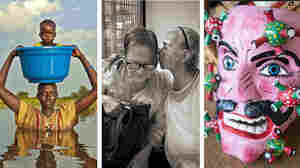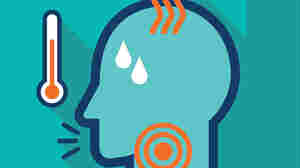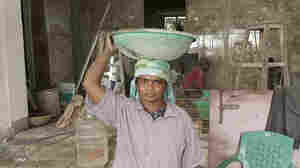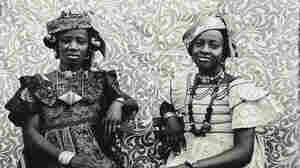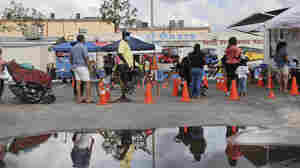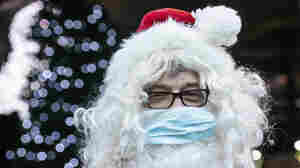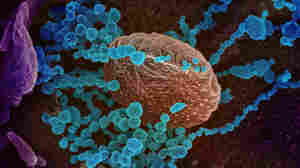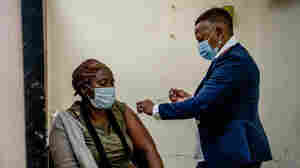Dr. Peter Hotez and Dr. Maria Elena Bottazzi of Texas Children's Hospital and Baylor College of Medicine have developed a new COVID vaccine that could prove beneficial to lower resource countries. They said their Texas location was key to the project: There were lots of local philanthropic groups that agreed to fund their research. Max Trautner/Texas Children's Hospital hide caption

Goats and Soda
STORIES OF LIFE IN A CHANGING WORLDMarried at 15, Chakraman Shreshta Balami fulfilled his dying father's wish by getting married — at age 15. He had to give up his dream of becoming a doctor. Now the vice principal of Sri Bhavani government school, he campaigns against child marriage — but even his son was married as a teenager. Above, he poses with a grandchild. Stephanie Sinclair for NPR hide caption
A colorized electron micrograph image of a cell (red) infected with with SARS-CoV-2 virus particles (yellow), isolated from a patient sample. Science Source hide caption
A 8-year-old looks out her bedroom window during self-quarantine with her family due to COVID-19. John Moore/Getty Images hide caption
An empty classroom during the pandemic in Seoul, South Korea. Chung Sung-Jun/Getty Images hide caption
Our correspondent Michaeleen Doucleff's daughter, Rosy, at age 2, as she does dishes voluntarily. Getting her involved in chores did lead to the kitchen being flooded and dishes being broken, Doucleff reports. But Rosy is still eager to help. Michaeleen Doucleff/NPR hide caption
How to raise kind kids, a booze ban, BTS at U.N.: Our top non-pandemic global stories
Selvi is a construction worker in Chennai, India. "My bones ache at night after carrying heavy loads through the day, my eyes sting from the dust and I cough often, but if I didn't do this, my kids and I would starve." she says. Kamala Thiagarajan for NPR hide caption
Seydou Keïta/SKPE—Courtesy CAAC—The Pigozzi Collection Seydou Keïta/SKPE/CAAC/The Pigozzi Collection hide caption
Dr. Elaha Ibrahimi uses her phone as a flashlight during a power cut inside the hospital in Mirbacha Kot, Afghanistan, in October. Health care workers have continued to work without salaries, without medicine for patients and with frequent power cuts. Bram Janssen/AP hide caption
Commuters wear masks to help curb the spread of the coronavirus during rush hour at the Shinagawa train station in Tokyo on Oct. 1. Case numbers have dropped significantly in Japan since summer. Researchers are trying to determine why. One theory is that the willingness to wear masks has made a difference; other theories are being investigated. Eugene Hoshiko/AP hide caption
Left to right: An illustration of the coronavirus, an illustration of the delta variant and a mural in India. Hanna Barczyk for NPR / Juan Gaertner/Science Source / Sanchit Khanna/Hindustan Times via Getty Images hide caption
People line up to receive a rapid COVID-19 test in an agricultural community in Immokalee, Fla., where the poverty rate is over 40%. Partners in Health is working with the Coalition of Immokalee Workers to test, educate and vaccinate the community during the pandemic. Spencer Platt/Getty Images hide caption
A Santa Claus in Germany wears a surgical mask in December 2020. If you're planning to take the kids to see Santa this year, experts say it's safest to keep everyone's masks on. Caroline Seidel/picture alliance via Getty Images hide caption
Sikhulile Moyo, the laboratory director at the Botswana-Harvard AIDS Institute Partnership and a research associate with the Harvard T.H. Chan School of Public Health, headed the team that identified the omicron variant. Leabaneng Natasha Moyo hide caption
A colorized scanning-electron-microscope image shows SARS-CoV-2 (the round blue objects) emerging from cells cultured in the lab. SARS-CoV-2 is the coronavirus that causes the disease COVID-19. NIAID-RML/Science Source hide caption
A woman is vaccinated against COVID-19 at a clinic in Johannesburg on Dec. 6. A new study from South Africa looks at the effectiveness of the Pfizer vaccine in preventing infection and severe disease. Shiraaz Mohamed/AP hide caption
Vaccine protection vs. omicron infection may drop to 30% but does cut severe disease
Denister Zambrano (25) lieutenant governor of the Amazonian indigenous community of Suni Caño, Peru. Angela Ponce for NPR hide caption
Vaccinators in Peru's Amazon are challenged by religion, rivers and a special tea
A line chart showing the rapid rise of COVID-19 test positivity driven by the omicron variant. NPR hide caption


